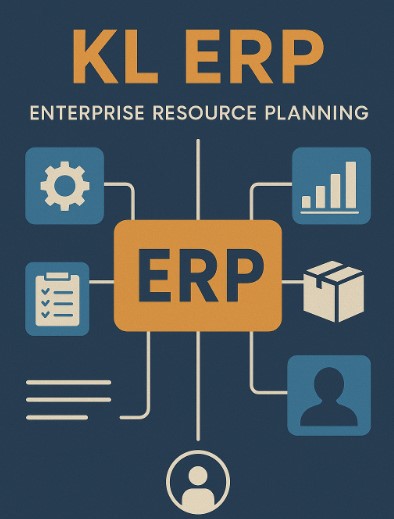KL ERP: The Future of Unified Business Intelligence
In a fast-paced world driven by data, automation, and efficiency, the term ERP—Enterprise Resource Planning—has become a cornerstone in the architecture of modern organizations. And standing at the intersection of innovation, customization, and performance is KL ERP—a robust, scalable, and intelligent ERP system designed to optimize operations, empower users, and redefine what it means to manage enterprise resources.
KL ERP isn’t just a system; it’s a digital ecosystem. Built with a deep understanding of business logic, workflow integration, and user-centric design, KL ERP offers organizations a way to harmonize their data, automate mundane tasks, and make data-driven decisions at scale.
Let’s dive into what makes KL ERP unique, how it works, and how it’s revolutionizing businesses across industries.

What is KL ERP?
KL ERP is an all-in-one enterprise solution that brings together core business processes—finance, human resources, procurement, inventory, project management, customer relationship management (CRM), and supply chain—under a single, unified interface.
Developed with cloud-native architecture and AI-enhanced capabilities, KL ERP delivers:
- Real-time analytics
- Workflow automation
- Data security and access control
- Mobile-responsive dashboards
- Integration with external systems (API-ready)
Whether a startup, an SME, or a large-scale enterprise, KL ERP is designed to scale and adapt to the unique complexities of any organization.
The Architecture of KL ERP: Modules in Motion
KL ERP is modular. Each module can work independently or as part of a connected suite, ensuring flexibility without compromising on power.
1. Financial Management Module
This module enables users to handle budgeting, general ledger, accounts payable/receivable, tax compliance, and financial forecasting with high precision.
- Multi-currency and multi-location support
- Auto-reconciliation and bank syncing
- Audit trails and report generators
2. Human Resource Management (HRM)
From recruitment to retirement, KL ERP’s HR module manages:
- Payroll and employee benefits
- Attendance and performance tracking
- Leave management and HR analytics
- Employee self-service portals
3. Inventory and Supply Chain
With KL ERP, organizations gain granular control over stock movements:
- Real-time stock updates
- Warehouse and logistics integration
- Demand forecasting and procurement planning
- Supplier relationship management
4. Project & Task Management
Teams can assign, track, and deliver projects efficiently with tools like:
- Gantt charts and Kanban boards
- Budget tracking
- Resource allocation
- Deadline and milestone alerts
5. CRM and Sales Management
Customer-centric growth is powered by:
- Lead and pipeline tracking
- Customer segmentation and communication history
- Integrated email/SMS campaigns
- Sales performance analytics
Why Businesses Choose KL ERP
What distinguishes KL ERP from other systems is not just its features—it’s the philosophy behind it.
1. User-First Design
KL ERP was designed with users in mind. Its intuitive UI/UX minimizes the learning curve, making onboarding faster and daily tasks smoother.
2. AI-Powered Intelligence
From predictive sales to smart inventory replenishment, KL ERP harnesses AI to anticipate needs and automate decisions.
3. Role-Based Access
Security is paramount. KL ERP allows administrators to define access levels based on job roles, ensuring data integrity and compliance.
4. Multi-Device Compatibility
Whether on desktop, tablet, or mobile, KL ERP offers full functionality. This ensures teams remain productive on the go.
5. Customization & Integration
Every business is different. KL ERP is customizable down to workflows, forms, and reports. It also integrates easily with third-party platforms like QuickBooks, Salesforce, or custom APIs.
A Day in the Life With KL ERP
Imagine a mid-sized manufacturing company using KL ERP. Here’s how its departments benefit:
- The Sales Team checks daily lead performance on the CRM dashboard, while automated follow-up emails are sent to prospects.
- Finance Managers reconcile bank transactions and view cash flow projections.
- HR manages payroll disbursement and interviews through the same portal.
- Inventory Managers receive alerts for low stock and reorder suggestions based on past trends.
- Executives track company performance through live dashboards.
With KL ERP, every stakeholder operates from a single source of truth.
Implementation Journey: From Deployment to Mastery
The deployment of KL ERP is not a plug-and-play operation—it’s a collaborative evolution. A typical rollout process includes:
- Assessment: Identifying current workflows and ERP needs.
- Customization: Tailoring modules to business operations.
- Data Migration: Ensuring secure and accurate transfer of legacy data.
- Training: Empowering staff with hands-on workshops and support.
- Go-Live & Support: Post-deployment monitoring and feedback loop.
KL ERP’s support team provides continuous help, from onboarding to version upgrades.
Industries Where KL ERP Excels
KL ERP’s versatility makes it a prime choice across industries:
- Manufacturing: Real-time production monitoring and inventory control
- Retail: Multi-branch sales tracking and demand forecasting
- Healthcare: Patient billing, staff scheduling, and compliance
- Education: Admission systems, student performance tracking
- Logistics: Shipment tracking, fleet management, and customer updates
The system adapts to the operational DNA of each sector.
Security and Compliance
KL ERP meets global data protection standards, including:
- ISO/IEC 27001:2013 for Information Security
- GDPR Compliance
- Multi-Factor Authentication (MFA)
- Role-based permissions and audit logs
This ensures peace of mind for data-sensitive industries.
The Future of KL ERP: Smart, Predictive, Autonomous
KL ERP’s roadmap is ambitious:
- Machine Learning Integration: For smarter forecasting and anomaly detection.
- Blockchain Features: Enhancing traceability and transaction validation.
- Voice-Activated Dashboards: ERP access via smart assistants.
- Sustainability Tracking: Measuring carbon footprints and green KPIs.
KL ERP isn’t just following trends—it’s shaping them.
Final Thoughts: Empowering Enterprises to Think Bigger
KL ERP isn’t just a tool—it’s a transformation partner. In a time where speed, precision, and insight define success, having a system that unifies every aspect of business operations is no longer a luxury—it’s a necessity.
With KL ERP, organizations unlock:
- Better decisions through data
- Greater collaboration across departments
- More time for strategy by automating routine
- A future-proof digital infrastructure
In short, KL ERP helps businesses do what they do best—only smarter, faster, and better.
